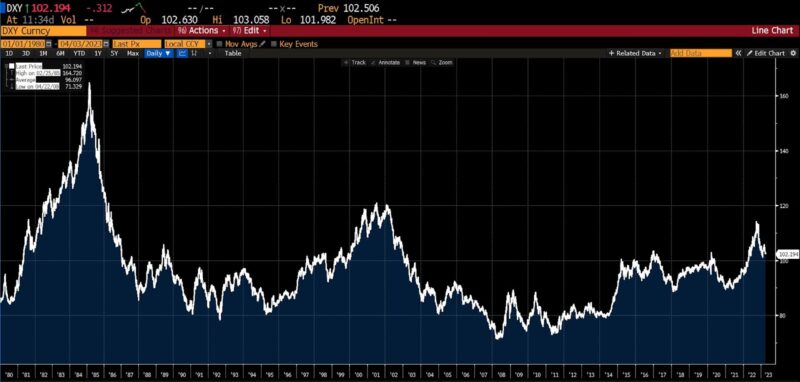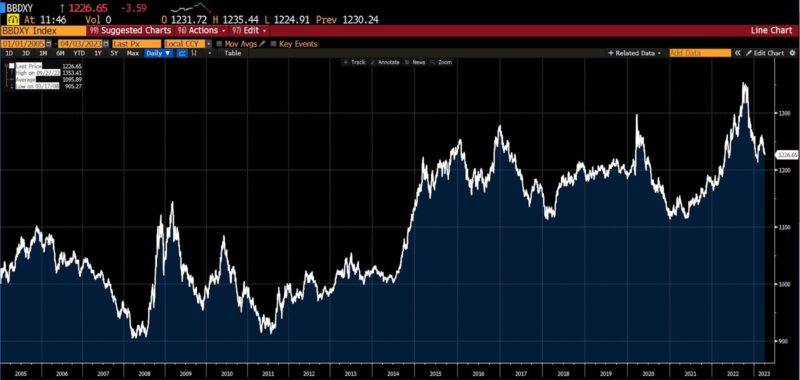Last week, China and Brazil reached an agreement to settle trades in one anothers’ currencies. Over the past 15 years, China has replaced the United States as the main trading partner of resource-rich Brazil, and as such that shift may have been inevitable. But within the context of recent circumstances, this appears to be another in a series of recent blows to the central role of the dollar in global trade.
As the world’s reserve currency, the US dollar is essentially the default currency in international trade and a global unit of account. Because of that, every central bank, Treasury/exchequer, and major firm on Earth keeps a large portion of their foreign exchange holdings in US dollars. And because holders of dollars seek returns on those balances, the ubiquity of dollars drives a substantial portion of the demand for US government bonds in world financial markets.
The switch from dollars to a yuan-real settlement basis in Chinese-Brazilian trade is only the latest in a growing trend. Discussions of a more politically neutral reserve currency have gone on for decades. The profound economic disruption experienced by Iran, and more recently Russia, after being evicted from dollar-based trading systems like SWIFT, however, have led many nations to consider imminent contingency plans. India and Malaysia, for example, have recently begun using the Indian Rupee to settle certain trades, and there have been perennial warnings about Saudi Arabia and other energy exporters moving away from the dollar. On that note, China also recently executed a test trade for natural gas with France settled in yuan.
DXY Index (1980 – present)

It’s not just the conscription of the dollar in economic warfare, but increasingly error-fraught monetary policy regimes that are driving various interests away from the greenback. The monetary policy response to the 2008 financial crisis saw the dollar’s value whipped around unpredictably, and the response to the outbreak of COVID was even more frenetic. The massively expansionary response to the pandemic in 2020 was followed by an initially dismissive posture toward the outbreak of inflation, which reached four-decade highs before an aggressive contractionary shift in policy that destabilized precarious financial institutions was implemented.
Simply replacing the fiat currency of the largest economy in the world with the fiat currency(s) of (a) smaller economy(s) is hardly a viable replacement strategy. Moving away from the dollar brings substantial barriers to exit as well as network effects to overcome, owing to historical, technological, financial, and habitual obstacles. The US dollar is the de facto currency of East Timor, Ecuador, El Salvador, the Federated States of Micronesia, the Marshall Islands, Palau, Panama, and Zimbabwe. Further, the (comparatively, relatively) transparent conduct of monetary policy in the US has led no less than 22 foreign central banks and currency boards to peg their currencies to it. And dollars are the cheapest means of access to acquire nominally risk-free US Treasury instruments.
Bloomberg Dollar Spot Index (2005 – present)

Some of the “twists” being discussed to provide alluring dollar replacements are cryptocurrencies, central bank digital currencies, or baskets of commodities representative of a given nation or region’s competitive advantage. The latter scenario, in which (for example) certain African nations would trade in currencies backed by titles to rare earth metals, some South American nations in currencies backed by copper deposits, and so on, is interesting but faces substantial hurdles. Nevertheless, a conference in New Delhi last week focusing on increased cooperation between Brazil, Russia, India, China, and South Africa touched on just such a plan. Variations of such a currency order have been dubbed “Bretton Woods III,” and some non-commodity proposals bear a curious similarity to the since-discarded Facebook currency plan first called Libra (later, ‘Diem’).
Owing to the role that dollar pervasiveness plays in the international appetite for US Treasuries, a side effect of the long-term attempt to establish alternative reserve currencies may be decreasing interest in tradable US debt. Over shorter time frames, that would likely result in higher yields and higher levels of debt service on securities issued by the US Treasury. Over generational time frames, that shift could force a reduction in US government spending. Should that scenario play out, the long-term effect of using access to dollars as a bludgeon of American foreign policy could well be higher average inflation and/or higher taxes on American citizens.
The dollar, in some shape or form, will likely be around for a long time. Perhaps very long. But by weaponizing dollar dominance and permitting expanding mandates to disorient US monetary policy, the dollar’s fate as the lingua franca of world commerce over the long haul may already be sealed. So long as the political will to moor US fiscal and monetary policies to those consistent with the constitution of sound money remain an inconversable matter, de-dollarization will proceed. And slower or more quickly, the dollar will lose ground abroad.
THIS ARTICLE ORIGINALLY POSTED HERE.




